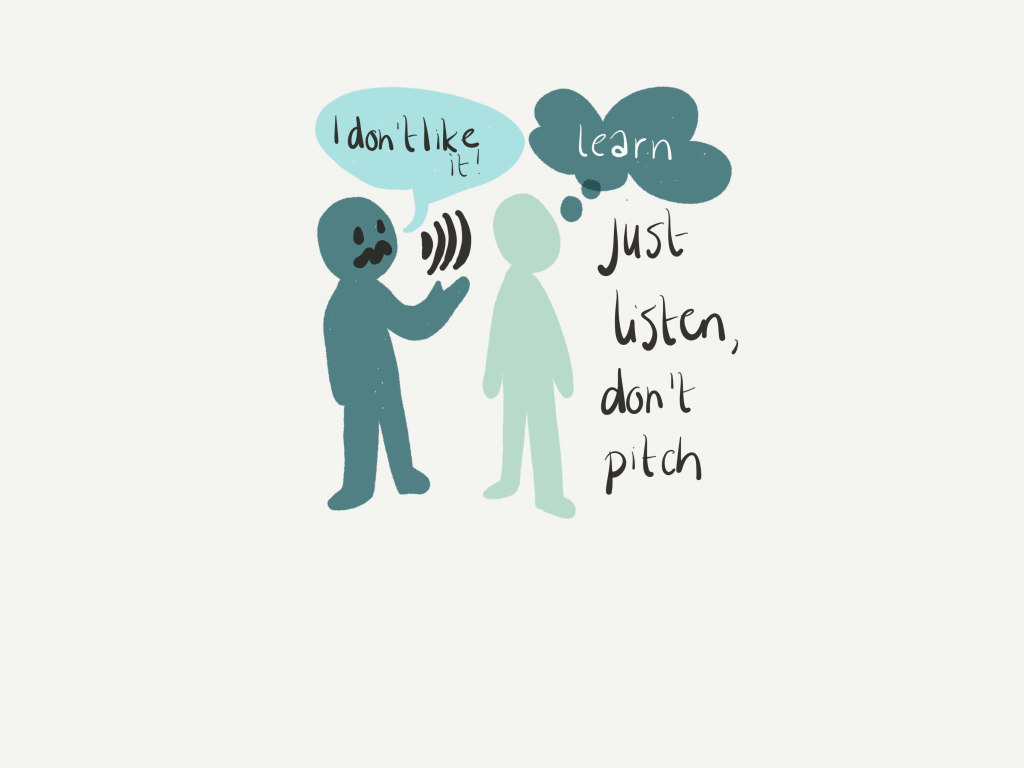Doing customer interviews: how to get to the actual value

This is Part 4 of our Lean Startup series.
One of the most important Lean Innvoation tools or experiments you can do throughout the search for your business model is the customer interview. Whether you are finding out if there is a problem, or want to know about what it really is that people are trying to do, the customer interview is an important tool in understanding more about the behavior and needs of your customer. Most startup founders we know tend to be scared by the notion of actually getting out of the building and start talking to strangers. They compile surveys and questionnaires they can conduct online and send out from behind their computers. Easier, far more comfortable, but the outcome will be averages rather than patterns. Talking to real people, listening to the things they say, their expression when saying it, will help you investigate and drill down to the why behind the what. You think they will not tell you? People love to complain about what is not working for them or to tell you all about their passion, all you have to provide is a listening ear.
Even though customer interviews remain awkward, there is a couple of things to help you feel more at ease. It is not that hard; You do not have to talk about your solution, you do not have to pitch. This is not about you or your product, this is about your customer. All you have to do is listen! Sounds easy enough right? Keep reminding yourself of this, because your first urge is to pitch your obviously brilliant solution. Don’t! Ask what they are doing to solve their problems instead, and why they are doing it.
Once you have found a good way to start conversations with potential customers the process will get easier and more and more valuable. We keep conducting customer interviews regularly, even though we are past the ‘prove there is a problem’ stage. Sometimes metrics show you a lot of things, but if you want to know the why, talking to people is always the most valuable option. Want to grow? Target more customers? Understand what your current customers are doing and why this will help you learn valuable insights.
How do you turn customer interviews into an experiment?
Box it! In time and in numbers. Be sure to interview as many people as possible in the time of a week. Or the dedicated days within your experiment loop. If you conduct interviews over a longer time, every single interview will slowly influence your overall view slightly. But by considering the whole of interviews as one experiment it will give you a chance to discover patterns and actually move forward from there.
Setting up for the interviews.
First, make sure that you know what it is that you want to learn. Define your hypotheses. Personally, I like to prepare questions that refer to a specific topic that I want to learn more about, related to the hypotheses. No follow up questions, just topic starters. In this way, I am able to make sure I tick off all the topics I want to ask questions about and still be able to drill down if something interesting comes up.
Asking the actual questions.
The other week while giving a workshop, somebody asked me; “I have talked to customers, they have all said they loved what I was doing, but now nobody is actually that enthusiastic about the real product. How do I get actual value out of those interviews, because to me it felt they were just lying.”
Since people usually say one thing but do another, this is indeed a very valid question. It is important to try and ask questions that will provide you with answers of high value. Believe it or not, everybody lies to you. Out of disinterest, just to be polite, because they want something else from you, or to not to destroy your dreams. The biggest liar is your biggest fan: Your mom. She will never want to destroy your dreams by telling you your idea sucks. Rob Fitzpatrick came up with a way to get valuable answers knowing that people lie to you. Every single question you ask should be asked in a way that even your mom cannot lie to you. He called this ‘The Mom Test‘.
Update: Previously, The Mom Test was not purchasable in Dutch translation. But because we find The Mom Test such a valuable book, we decided to translate it into dutch in co-operation with Rob. You can find more information about the Dutch version here.
The Basics:
Stop fishing for compliments, this is not about you or your product, this is about the world of the customer and how they perceive their problem.

Avoid generics or abstracts, this will only lead to guesstimates. Ask about real events and what they did dealing with them.

Never ask questions that contain would or should, nobody can predict their future. Ask what they are doing to solve their problem right now instead.

What you do want is to know what they perceive as a problem, what they are doing to solve it, and ‘why’ they are doing this.
The Analysis
Now when you have interviewed a good number of customers it is time to analyze data and make decisions from there. Start by writing every single answer on a separate sticky note. (if it helps jot down a number or initials to refer back to the interviewee) lay the stickies out in a grid. Where the interviewee is played out across columns and the topics across rows. Make sure to leave some room in the row section since there are going to be different and more than one answers available here. Stick answers in the grid. Now start looking for similar answers or problems and group them together.
Can your hypotheses be validated?
Always make sure to take pictures.
See if there are any other patterns emerging.
It feels like a lot of work, but doing this as a team will lead to valuable insights. Your brain is (still) the best pattern recognition system there is in the world, you will ‘see’ patterns sticking out to you. Leaving through the answers that are written down will not give you the insights it will when visualizing it.

For instance; We interviewed high school students on the use of a calendar. The hypothesis was that high school students have problems with existing calendar apps while no longer using paper calendars because they forget them or find them archaic. By determining a more specific segment we wanted to see if we could see if the problem was different or maybe more prevalent in order to offer more value in our intended solution. I prepared some topics that I wanted to learn more about: Current apps on their phones. Classroom and school digital approach. Paper calendar (did they use it before , if so how). Context of given homework and tests. Their planning and learning rituals (if any).
We validated our hypotheses with a specific group of students we were able to identify. But the real value was the insight that their biggest problem (they all voluntarily gave this information when we saw signs of frustration) was something we didn’t know about. They felt tests and homework seemed to sneak up on them. Tests that only showed up on the actual day, or a day before. They all blamed it on something else, the teacher, yet another crappy calendar app, the system, never themselves. But it was a problem for them because it affected their scores.
This ‘job-to-be-done’ became an important part of the new value proposition and the solution. Asking ‘why’ helped us rethink our value proposition. Now, instead of

Esther Gons is the award-winning author of The Corporate Startup & Innovation Accounting. Winner of the 2022 Golden Axiom Business Book Award, 2019 Golden Axiom Business Book Award, and the 2018 Management Book Of The Year Award. She is an expert in Innovation Accounting, Innovation Strategy and Portfolio Management.
